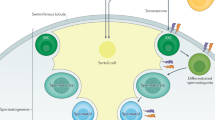Abstract
Knowledge of the impact of different conditioning regimens used in bone marrow transplantation on spermatogenesis is important in pre-BMT counselling for three reasons: (1) Most young patients who have not had children are concerned with their subsequent fertility; (2) For a number of diseases there are competing therapeutic options that may affect spermatogenesis more or less seriously; (3) Since spontaneous recovery of spermatogenesis is rare, it would be necessary to offer cryopreservation as soon as possible after diagnosis and prior to any treatment. This retrospective study evaluates 99 semen samples obtained in 64 patients who underwent BMT between 1982 and 1996. Recovery of spermatogenesis was observed in 90% of patients conditioned with cyclophosphamide (CY), in 50% of patients with CY plus busulphan (BU) or thiotepa and in 17% of patients with CY plus total body irradiation (TBI) or thoracoabdominal irradiation (TAI). Sperm quality following CY was within the normal range (WHO) in the majority of patients, whereas it was consistently severely impaired in patients who received irradiation or two alkylating agents. Following CY, spermatogenesis recovery was observed in 60% of patients tested 1 year post transplant and it was accomplished within the third year in 80% of cases. Following CY + TBI/TAI recovery of spermatogenesis never occurred before the 4th year post transplant and was demonstrated as late as 9 years in one patient who was azoospermic 1 year earlier. No statistical correlation between age and recovery of spermatogenesis could be demonstrated. The overall high incidence of azoospermia (70.3%) supports the indication for semen cryopreservation in young patients undergoing BMT. These results have implications for semen sample timing before and after BMT and underline a need to collect further data through prospective multi-center studies.
This is a preview of subscription content, access via your institution
Access options
Subscribe to this journal
Receive 12 print issues and online access
$259.00 per year
only $21.58 per issue
Buy this article
- Purchase on Springer Link
- Instant access to full article PDF
Prices may be subject to local taxes which are calculated during checkout


Similar content being viewed by others
References
World Health Organisation. WHO Laboratory Manual for the Examination of Human Semen and Sperm Cervical Mucus Interaction Press Concern: Singapore, 1980; Cambridge University Press: Cambridge 1999
Sanders JE, Hawley J, Levy W et al. Pregnancies following high-dose cyclophosphamide with or without high-dose busulfan or total-body irradiation and bone marrow transplantation Blood 1996 87: 3045 3052
Pakka S, Lukka M, Helminen P et al. Paternity after bone marrow transplantation following conditioning with total body irradiation Bone Marrow Transplant 1994 13: 489 490
Jacob A, Goodman A, Holmes J . Fertility after bone marrow transplantation following conditioning with cyclophosphamide and total body irradiation Bone Marrow Transplant 1995 15: 483 485
Letendre L, Moor SB . Successful pregnancy after conditioning with cyclophosphamide and fractionated total body irradiation Med Pediatr Oncol 1997 28: 147 148
Gulati SC, Van Poznak C . Pregnancy after bone marrow transplantation J Clin Oncol 1998 16: 1978 1985
Trasler MJ, Hales F, Robaire B . Paternal cyclophosphamide treatment of rats causes fetal loss and malformations without affectingmale fertility Nature 1985 316: 144 146
Brinkworth MH . Paternal transmission of genetic damage: findings in animals and humans Int J Androl 2000 23: 123 135
Robbins WA, Meistrich ML, Moore D et al. Chemotherapy induces transient sex chromosomal and autosomal aneuploidy in human sperm Nat Genet 1997 16: 74 78
Martin RH, Ernest S, Rademaker A et al. Analysis of sperm chromosome complements before, during and after chemotherapy Cancer Genet Cytogenet 1998 15: 133 136
Aron J, Meirow D, Lewis-Roness H, Ornoy A . Genetic and teratogenic effects of cancer treatments on gametes and embryos Hum Reprod Update 2001 7: 394 403
Naysmith TE, Blake DA, Harvey VJ, Johnson NP . Do men undergoing sterilising cancer treatments have a fertile future? Hum Reprod 1998 13: 3250 3255
Lass A, Akagbosu F, Brinsden P . Sperm banking and assisted reproduction treatment for couples following cancer treatment of the male partner Hum Reprod Update 2001 7: 370 377
Sanders JE, Buckner CD, Leonard JM et al. Late effects on gonadal function of cyclophosphamide, total body irradiation, and marrow transplantation Transplantation 1983 36: 252 255
Jacob A, Barker H . Recovery of spermatogenesis following bone marrow transplantation Bone Marrow Transplant 1998 22: 277 279
Grigg AP, McLachlan R, Zajac J, Szer J . Reproductive status in long-term bone marrow transplant survivors receiving busulfan-cyclophosphamide (120 mg/kg) Bone Marrow Transplant 2000 26: 1089 1095
Spinelli A, Chiodi A, Bacigalupo A et al. Ovarian recovery after total body irradiation and allogeneic bone transplantation: long-term follow-up of 79 females Bone Marrow Transplant 1994 14: 373 380
Author information
Authors and Affiliations
Rights and permissions
About this article
Cite this article
Anserini, P., Chiodi, S., Spinelli, S. et al. Semen analysis following allogeneic bone marrow transplantation. Additional data for evidence-based counselling. Bone Marrow Transplant 30, 447–451 (2002). https://doi.org/10.1038/sj.bmt.1703651
Received:
Accepted:
Published:
Issue Date:
DOI: https://doi.org/10.1038/sj.bmt.1703651
Keywords
This article is cited by
-
Microdissection testicular sperm extraction after pediatric allogeneic hematopoietic stem cell transplantation: a case series
Bone Marrow Transplantation (2024)
-
Male-specific late effects in adult hematopoietic cell transplantation recipients: a systematic review from the Late Effects and Quality of Life Working Committee of the Center for International Blood and Marrow Transplant Research and Transplant Complications Working Party of the European Society of Blood and Marrow Transplantation
Bone Marrow Transplantation (2022)
-
Anti-Müllerian hormone and Inhibin B after stem cell transplant in childhood: a comparison of myeloablative, reduced intensity and treosulfan-based chemotherapy regimens
Bone Marrow Transplantation (2020)
-
A systematic approach to the endocrine care of survivors of pediatric hematopoietic stem cell transplantation
Cancer and Metastasis Reviews (2020)



